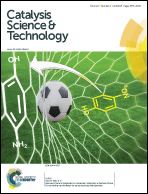Experimental and DFT studies on Sr-doped LaMnO3 catalysts for NOx storage and reduction
Abstract
The idea of rational design of perovskite catalysts for NOx storage and reduction (NSR) starts from DFT studies on Sr-doped LaMnO3 (001) plane models: a Mn-terminated plane (Mn-ter) has a higher activity than La- or Sr-ter planes; the number of A-site defects increases when Sr is doped on the surface; O-vacancy formation energies for both La- and Mn-ter gradually decrease with increased Sr loading, and the values for La-ter are always larger than for Mn-ter with the same Sr loading, indicating that the O-vacancy formation is facile on Mn-ter with Sr-doping. This model yields the highest reactivity for oxidation and the lowest energy barrier for O-vacancy formation. A surface tuning method for La0.5Sr0.5MnO3 is introduced. With the exception of the promotion of surface area and pore volume, the ratio of Sr/La and the number of surface-active oxygen atoms and Mn4+ cations exposed on the outermost layers are improved with an increased contact time between the raw materials and dilute HNO3. However, overtreatment leads to a less stable phase of MnO2 with a high reducibility but significantly restrained NOx adsorption. NSR performances under lean-burn/fuel-rich cycles are measured, and the results correspond well with the NO adsorption or oxidation behaviors and DFT calculations.


 Please wait while we load your content...
Please wait while we load your content...